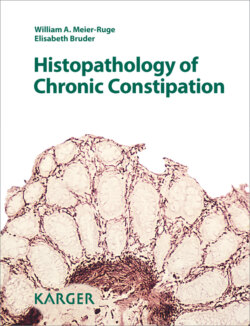Читать книгу Histopathology of Chronic Constipation - W.A. Meier-Ruge - Страница 7
На сайте Литреса книга снята с продажи.
Introduction
ОглавлениеChronic constipation is a fairly frustrating matter in classical histopathology as hemalum-eosin staining allows only a limited diagnostic statement. This, however, has changed in recent decades. Today, the foundation of histopathological diagnosis of gastrointestinal motility disorder is enzyme histochemistry. Many different gut diseases have been clearly diagnosed by enzyme histochemical techniques, such as Hirschsprung’s disease (HD), ultra-short rectum aganglionosis, hypoganglionosis, immaturity of the enteral nervous system, intestinal neuronal dysplasia, and atrophic alterations of the lamina propria [1, 2].
Compared to enzyme histochemistry, immunohistochemistry in paraffin-embedded formalin-fixed tissue is presently only of limited value. The diagnosis of HD was a breakthrough for enzyme histochemistry. It is possible to diagnose HD reliably in rectum mucosa biopsies with the aid of an acetylcho-linesterase reaction [3-5], which has become the gold standard in the diagnosis of HD [1, 6-8]. Today, enzyme histochemistry is the technique of choice in experimental pathology, as well as in the histopathological differential diagnosis of chronic constipation [9].
